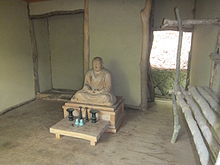Saigyō
Saigyō ( Japanese 西行 ; born 1118 in Kyōto ; died 1190 ), also Saigyō Hōshi (西行 法師); actually: Satō Norikiyo ( 佐藤 義 清 ), was a Japanese poet and monk.
Life
Saigyō, a descendant of Fujiwara no Hidesato ( 藤原 秀 郷 ; 10th century), was actually called Satō Norikiyo. He was born in Kyoto to a wealthy family who had served the imperial court for generations. He was very skilled with bow and arrow and was good at poetry, whereupon he became a favorite of the ex-emperor Toba , who gave him the title Hokumen no bushi (北面 武士). He grew up at a time when power in the state was shifting from the court nobility to the rising class of the sword nobility. At the age of 16 he served the Tokudaiji House. At the age of 18 he was granted the third degree Imperial Guard.
But at the age of 23 he gave up his wife and children, went to Saga and became a monk ( 法師 , hōshi ) of the Buddhist Shingon school . First he called himself Eni ( 円 位 ), then Saigyō. The status of a monk enabled him to live a comparatively free wandering life, in the course of which he wrote an abundance of verses that he recited on the way.
This unbound life displeased the famous priest Mongaku , who criticized him as a bad Buddhist. Mongaku went so far as to say that if he met him, he would kill him. When Saigyō heard this, he sought Mongaku in his temple Shingo-ji ( 神 護 寺 ) on Mount Takao and faced him. Mongaku was very impressed by him.
Saigyō then made his way to Kamakura , where Minamoto no Yoritomo received him, who then enjoyed talking to him about poetry and the art of archery. When he said goodbye, Yoritomo gave Saigyō a silver cat, which he passed on to the first child he saw on the way. - Saigyō then went to northern Japan, where he could stay with one of his relatives, Fujiwara no Hidehira.
Saigyō exerted a great influence on later poets up to Sōgi (1421-1502) and Matsuo Bashō (1644-1694). By contemporaries and later generations he was valued as the archetype of the wandering poet or poet monk.
style
Saigyō was enthusiastic about the beauty of nature , this is also reflected in his works.
Work edition in German translation
- Saigyō: Poems from the Bergklause: Sakashū , selected and translated with an introduction and commentary by Ekkehard May. Reference library Dieterich. Dieterich'sche Verlagbuchhandlung: Mainz 2018. ISBN 978-3-87162-098-0 .
literature
- Saigyō: Mirror for the Moon: A Selection of Poems by Saigyō (1118–1190) , translated by William R. LaFleur, New Directions 1978
- Saigyō: Poems of a Mountain Home , Columbia Univ. Pr .; 1992, ISBN 0-231-07493-X
- More Love Poems (101-200) , Oriental Book Store, 1981, ISBN 0-686-37537-8
- As a Love Poet: One Hundred More Selections , Oriental Book Store, 1981, ISBN 0-686-37540-8
- Papinot, Edmond: Saigyo . In: Historical and Geographical Dictionary of Japan. Reprinted by Tuttle, 1972 edition of 1910 edition. ISBN 0-8048-0996-8 .
Web links
- carlsensei.com (Classical Japanese Database)
| personal data | |
|---|---|
| SURNAME | Saigyō |
| ALTERNATIVE NAMES | 西行 (Japanese); Satō Norikiyo (real name); 佐藤 義 清 (real name, Japanese) |
| BRIEF DESCRIPTION | Japanese poet and monk |
| DATE OF BIRTH | 1118 |
| PLACE OF BIRTH | Kyoto |
| DATE OF DEATH | 1190 |



